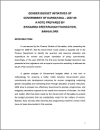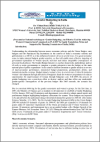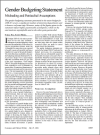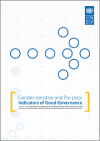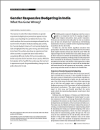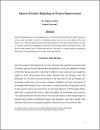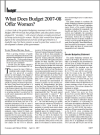أسس 9
The guide brings together and synthesises several innovative and tested strategies on gender responsive planning & implementation from across India.
Following a commitment by the Finance Minister of Karnataka to create a separate cell in the Finance Department tasked with identifying the quantum and resource allocation and expenditure for women, the first ever Gender Budget document was presented in the year 2007-08 at the Legisla
In India, Gender budgeting as a distinct tool was institutionalized by the introduction of gender budgeting statement in the Union Budget 2005-06.
Gender Budgeting in India by Dr. Vibhuti Patel was presented at a National workshop on Gender Budgeting: An Effective Tool for Achieving Women's Empowerment, organised on 15-4-2007 by Equity Foundation, Patna and Supported by Planning Commission of India, Delhi.
The article draws attention to the numerous assumptions relating to the proportion of allocations under a scheme that directly benefits women which unfortunately form the basis of the Gender Budgeting exercise.
This paper was prepared as a background to the UNDP Oslo Governance Centre and Indian Council for Social Science Research (ICSSR) International workshop on engendering and empowering governance indicators, New Delhi, April 2005.
The article examines the two main strategies adopted by the Government of India for institutionalizing gender responsive budgeting to highlight what has gone wrong and what needs to be fixed in order to achieve better outcomes for women.
This paper is an attempt to measure the effectiveness of Gender Budgeting as a tool for women empowerment. In recent years, Gender Budget Initiatives have emerged as an effective way to bridge gender gaps.
This article takes a closer look at the gender budgeting statement in the Union Budget 2007-08 in India and reveals that programmes and allocations remain plagued by mistakes, with several schemes wrongly prioritised as being exclusively for women. Economic and Political Weekly April 21, 2007

